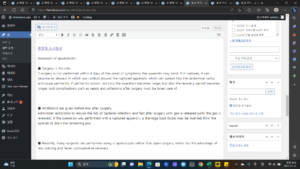Is it appendicitis when the right side of the stomach hurts, different from the abdominal pain before defecation? You must have been worried about it. Unlike in the past, appendicitis is not a serious disease these days and is easily treatable. If you know the initial symptoms and causes of appendicitis and know how to diagnose and treat it in advance, you can treat it early without complications.
One of my family members had also had an operation for appendicitis, and I suspected appendicitis as an early symptom, so I went to the hospital without delay. Thanks to the quick arrival, the inflammation did not spread significantly and was easily removed surgically. I hope you will also get to know the initial symptoms in this post today and get tested early when appendicitis is suspected.
What is Appendicitis?
● The correct name is appendicitis.
Appendicitis is the most common cause of abdominal pain requiring surgery. At the end of the appendix, there is a 6 to 9 cm long appendix, which means that this part is inflamed.
● Depending on the degree of progression, it is classified into early appendicitis, purulent appendicitis, gangrenous appendicitis, and perforated appendicitis.
The clinical picture of acute appendicitis varies depending on whether there is a perforation or not. Unperforated appendicitis causes indigestion, abdominal pain in the lower right area, and mild fever. In perforated appendicitis, a mass caused by an abscess around the appendix may be palpable or disseminated peritonitis may occur.
What causes appendicitis?
● It starts when the inside of the appendix becomes blocked.
When the appendix is blocked, the normal movement of the intestine from the appendix to the large intestine is restricted, causing intestinal bacteria to multiply and release toxic substances. These substances can damage the lining of the appendix and cause ulceration.
● Clogged (obstructed) causes
Hyperproliferation of lymphoid tissue around the appendix is the most common cause, and hard stool flows into the appendix to block the entrance, foreign substances, or inflammatory strictures are also causes.
early symptoms of appendicitis
colic
● Loss of appetite, upset stomach (nausea), and epigastric pain. There are also cases of vomiting 1 or 2 times, and there is no symptom in the right lower abdomen where the appendix is located, or only slight tenderness when pressed with the hand.
● Upper abdominal pain gradually changes to right lower abdominal pain over time. At this time, tenderness becomes evident when pressing with the hand, and painful rebound pain appears when pressing and releasing the hand. You may also have a slight fever and feel chills.
● If appendicitis perforates, the pain is more severe and spreads to the entire lower abdomen or the entire abdomen, not just the right lower abdomen.
● The location of the appendix may differ slightly from person to person. Depending on the location of the appendix, there may be pain in the right flank. of vague discomfort may appear.
How is appendicitis diagnosed?
The most important thing is whether there is pain when the part where the appendix is located is pressed. It’s called ‘McBurney Point’, and it is a point one-third outward from an imaginary line connecting the navel and the protruding bone of the front of the pelvis. Diagnosis is made by symptoms such as bloating, lower right abdomen (especially with or without tenderness at McBurney’s point), low-grade fever, and increased white blood cells. Since symptoms may be ambiguous or it may be difficult to determine with only simple examination and blood test findings, CT or ultrasound is performed to increase accuracy.
treatment of appendicitis
● Surgery is the rule.
If surgery is not performed within 3 days of the onset of symptoms, the appendix may burst. If it ruptures, it can become an abscess in which pus collects around the ruptured appendix, which can spread into the abdominal cavity and cause peritonitis. If peritonitis occurs, not only the operation becomes larger, but also the recovery period becomes longer, and complications such as sepsis and adhesions after surgery must be taken care of.
● Antibiotics are given before and after surgery.
Administer antibiotics to reduce the risk of bacterial infection, and fast after surgery until gas is released (until the gas is released). If the operation was performed with a ruptured appendix, a drainage tube (tube) may be inserted from the outside to drain the remaining pus.
● Recently, many surgeries are performed using a laparoscopic rather than open surgery, which has the advantage of less scarring and faster postoperative recovery.